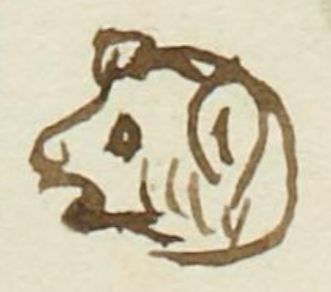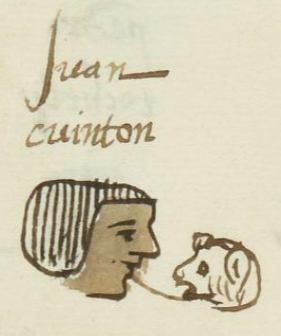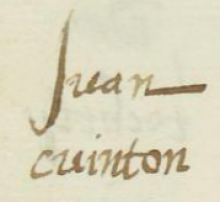Cuinton (MH509r)
This black-line drawing of the simplex glyph for the personal name Cuinton (here, attested as a man's name) shows the head of a dog (izcuintli) in profile looking toward the viewer's left. Its coat is somewhat textured, its ears are up, and its mouth is open. The line indicating its nose has a little curve to it.
Stephanie Wood
The diminutive suffix on the name (-ton) could be built into the relative size (visually) of this image, but without a comparison, that is difficult to assess. These dogs were small as a rule, nothing like the size of the dogs brought to Mesoamerica by the Europeans. People still today will refer to small children, affectionately, as izcuintli. The izcuintli is a day sign in the calendar, so it is not unusual to see variations on the word for names (as here, where the iz- has dropped away). According to twentieth-century ethnography, a nahualli could take the shape of a dog. See Los cuentos en náhuatl de Doña Luz Jiménez, recop. Fernando Horcasitas and Sarah O. de Ford (México, UNAM, 1979), 32–33.
Stephanie Wood
Juan
cuinton
Juan Cuinton
Stephanie Wood
1560
Jeff Haskett-Wood
dogs, perros, perritos, diminutivo, nombres de hombres

izcuin(tli), dog, https://nahuatl.wired-humanities.org/content/itzcuintli
-ton(tli), diminutive suffix, https://nahuatl.wired-humanities.org/content/tontli
El Perrito
Stephanie Wood
Matrícula de Huexotzinco, folio 509r, World Digital Library, https://www.loc.gov/resource/gdcwdl.wdl_15282/?sp=97&st=image
This manuscript is hosted by the Library of Congress and the World Digital Library; used here with the Creative Commons, “Attribution-NonCommercial-ShareAlike 3.0 License” (CC-BY-NC-SAq 3.0).


